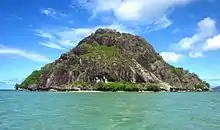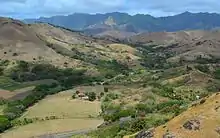Ra is one of the fourteen provinces of Fiji. Occupying the northern area of Viti Levu, the largest island, it is one of eight Viti Levu-based Provinces. With a land area of 1,341 square kilometers, it had a population of 30,432 in 2017 census.[1] The main urban centre is at Vaileka, with a population of 3,361 in 1996.

The province has 19 districts:[2]
- Bureivanua
- Bureiwai
- Kavula
- Lawaki
- Mataso
- Nababa
- Nailuva
- Nakorotubu
- Nakuilava
- Nalaba
- Nalawa
- Naroko
- Nasau
- Navitilevu
- Navolau
- Rakiraki
- Raviravi
- Saivou
- Tokaimalo
The districts of Saivou, Nakorotubu, Rakiraki, and Nalawa have their own chiefs: the Gone Turaga na Vunivalu na Tui Nalawa, Gone Marama na Ratu ni Natauiya Turaga na Gonesau, and Gone Turaga Tu Navitilevu.
Ra Province has 19 tikina makawa and has 86 villages.

Ra as a whole is governed by a Provincial Council, currently chaired by Mr. Simione Naikarua who was a former Board Secretary of Airport Fiji Limited and former Chief Executive Officer of the Nasinu Town Council. He hails from Burenitu village in the district of Nalawa in Ra.
There was an attempt in 2015 to create a "Christian state" in Ra. This was described by the then Chief of Police, Ben Groenewald, as a harmless cult, but the prime minister Frank Bainimarama took a sterner view and ordered a clamp-down by the army. It was due to claims by the “cult” that the constitution of Fiji violated the UN's 2007 Declaration on the Rights of Indigenous Peoples (DOTROIP). But to ask for the UN's help, they deemed that they had to be a nation, hence The Ra Christian State was envisioned to contest the constitution. Many of the conspirators were imprisoned for sedition and treason.[3]

The Ra dialect of Fijian is distinctive in that the consonant /t/, pronounced elsewhere in Fiji, is pronounced as a glottal stop.
References
- ↑ Fiji Bureau of Statistics (5 January 2018). "2017 Population and Housing Census - Release 1". Census 2017. Archived from the original on 20 March 2018. Retrieved 8 April 2018.
- ↑ "Archived copy" (PDF). Archived from the original (PDF) on 2019-09-03. Retrieved 2019-09-03.
{{cite web}}: CS1 maint: archived copy as title (link) - ↑ The Economist, 23 January 2016, p. 53.
17°30′S 178°10′E / 17.500°S 178.167°E